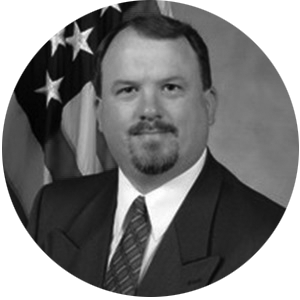Agenda
Times are subject to change.

Bradley Peniston
Executive EditorDefense One

Bradley Peniston
Executive EditorDefense One
As the Department of Defense advances its unified cloud vision to support JADC2, mission resilience, and digital modernization, this session takes a retrospective look at progress to date and what’s next. Former Deputy CIO Danielle Metz will share lessons learned from her time at DoD, offer insights on aligning enterprise and service-specific initiatives, and provide her perspective on the opportunities and challenges shaping the Pentagon’s cloud, software, and emerging technology strategy.
As the Department of Defense advances its unified cloud vision to support JADC2, mission resilience, and digital modernization, this session takes a retrospective look at progress to date and what’s next. Former Deputy CIO Danielle Metz will share lessons learned from her time at DoD, offer insights on aligning enterprise and service-specific initiatives, and provide her perspective on the opportunities and challenges shaping the Pentagon’s cloud, software, and emerging technology strategy.

Danielle Metz
Former Deputy CIOFormer Department of Defense

Anna Pettyjohn
EVP, Product & StrategyGovExec
As the Department of Defense advances its unified cloud vision to support JADC2, mission resilience, and digital modernization, this session takes a retrospective look at progress to date and what’s next. Former Deputy CIO Danielle Metz will share lessons learned from her time at DoD, offer insights on aligning enterprise and service-specific initiatives, and provide her perspective on the opportunities and challenges shaping the Pentagon’s cloud, software, and emerging technology strategy.

Danielle Metz
Former Deputy CIOFormer Department of Defense

Anna Pettyjohn
EVP, Product & StrategyGovExec
The Department of Defense is undergoing a significant transformation, with digital technologies and cloud innovations at the forefront of its modernization efforts. This fireside chat will discuss how Google Cloud is addressing the critical need for efficient cloud implementation across defense. We'll explore the evolving landscape of defense cloud technology, highlight key challenges, and demonstrate how our secure, scalable solutions empower the DoD to communicate, store, and process data more effectively, ultimately strengthening national security.
The Department of Defense is undergoing a significant transformation, with digital technologies and cloud innovations at the forefront of its modernization efforts. This fireside chat will discuss how Google Cloud is addressing the critical need for efficient cloud implementation across defense. We'll explore the evolving landscape of defense cloud technology, highlight key challenges, and demonstrate how our secure, scalable solutions empower the DoD to communicate, store, and process data more effectively, ultimately strengthening national security.

Jan Niemiec
Managing Director for Defense and National SecurityGoogle Public Sector

Tom Suder
CEOATARC
The Department of Defense is undergoing a significant transformation, with digital technologies and cloud innovations at the forefront of its modernization efforts. This fireside chat will discuss how Google Cloud is addressing the critical need for efficient cloud implementation across defense. We'll explore the evolving landscape of defense cloud technology, highlight key challenges, and demonstrate how our secure, scalable solutions empower the DoD to communicate, store, and process data more effectively, ultimately strengthening national security.

Jan Niemiec
Managing Director for Defense and National SecurityGoogle Public Sector

Tom Suder
CEOATARC

As the DoD expands its multi-cloud architecture, both the threat landscape and user expectations grow in complexity. This session will explore how artificial intelligence (AI) is being leveraged not only to enhance cybersecurity through real-time threat monitoring, automated responses, and improved security posture, but also to elevate customer experience (CX) by delivering more seamless, efficient, and responsive digital services. Attendees will learn how AI is becoming essential to both safeguarding mission-critical systems and ensuring that end users can securely and effectively engage with the tools they need in an era of digital warfare. DoD experts will explore the evolution of the cyber and digital services landscape as the department focuses on the adoption and implementation of new technologies and moves toward improved security, automation, and data access. Attendees will walk away with recommended strategies for agencies to modernize their SOCs, service delivery, data management, security, and privacy while meeting mission-critical needs and partnering with commercial organizations.
As the DoD expands its multi-cloud architecture, both the threat landscape and user expectations grow in complexity. This session will explore how artificial intelligence (AI) is being leveraged not only to enhance cybersecurity through real-time threat monitoring, automated responses, and improved security posture, but also to elevate customer experience (CX) by delivering more seamless, efficient, and responsive digital services. Attendees will learn how AI is becoming essential to both safeguarding mission-critical systems and ensuring that end users can securely and effectively engage with the tools they need in an era of digital warfare. DoD experts will explore the evolution of the cyber and digital services landscape as the department focuses on the adoption and implementation of new technologies and moves toward improved security, automation, and data access. Attendees will walk away with recommended strategies for agencies to modernize their SOCs, service delivery, data management, security, and privacy while meeting mission-critical needs and partnering with commercial organizations.

Renata Spinks
Former CISO and Deputy CIO, IC4, USMC and CEOCyberSec International, Inc.

Anna Pettyjohn
EVP, Product & StrategyGovExec
As the DoD expands its multi-cloud architecture, both the threat landscape and user expectations grow in complexity. This session will explore how artificial intelligence (AI) is being leveraged not only to enhance cybersecurity through real-time threat monitoring, automated responses, and improved security posture, but also to elevate customer experience (CX) by delivering more seamless, efficient, and responsive digital services. Attendees will learn how AI is becoming essential to both safeguarding mission-critical systems and ensuring that end users can securely and effectively engage with the tools they need in an era of digital warfare. DoD experts will explore the evolution of the cyber and digital services landscape as the department focuses on the adoption and implementation of new technologies and moves toward improved security, automation, and data access. Attendees will walk away with recommended strategies for agencies to modernize their SOCs, service delivery, data management, security, and privacy while meeting mission-critical needs and partnering with commercial organizations.

Renata Spinks
Former CISO and Deputy CIO, IC4, USMC and CEOCyberSec International, Inc.

Anna Pettyjohn
EVP, Product & StrategyGovExec
In today’s complex cyber landscape, federal agencies must adopt a zero-trust architecture (ZTA) to protect sensitive data by securing overall information ecosystem: processes, technology and the individuals that support the corporation. Building Trust begins with ‘Not Trusting”; sound familiar to the way you manage your trusted relationships. ZTA assumes all networks and users are potentially compromised, requiring continuous verification and strict access controls using dynamic automation. This architecture integrates security into every aspect of the information ecosystem to ensure mission success from the outset and to also continue operations when under attack. ZTA minimizes the attack surface, enhances threat detection and response by aligning with the National Institute of Standards and Technology’s Cybersecurity Framework. Despite the White House’s original September 2024 deadline, now pushed to 2027, agencies must leverage AI, automation, and advanced strategies to fortify their zero-trust frameworks and ensure long-term security. They must have a comprehensive view of the entire ecosystem of an organization of the People, Process and Technology.
In today’s complex cyber landscape, federal agencies must adopt a zero-trust architecture (ZTA) to protect sensitive data by securing overall information ecosystem: processes, technology and the individuals that support the corporation. Building Trust begins with ‘Not Trusting”; sound familiar to the way you manage your trusted relationships. ZTA assumes all networks and users are potentially compromised, requiring continuous verification and strict access controls using dynamic automation. This architecture integrates security into every aspect of the information ecosystem to ensure mission success from the outset and to also continue operations when under attack. ZTA minimizes the attack surface, enhances threat detection and response by aligning with the National Institute of Standards and Technology’s Cybersecurity Framework. Despite the White House’s original September 2024 deadline, now pushed to 2027, agencies must leverage AI, automation, and advanced strategies to fortify their zero-trust frameworks and ensure long-term security. They must have a comprehensive view of the entire ecosystem of an organization of the People, Process and Technology.

Richard Breakiron
Senior Director, Strategic Initiatives and Executive ProgramsCommvault
In today’s complex cyber landscape, federal agencies must adopt a zero-trust architecture (ZTA) to protect sensitive data by securing overall information ecosystem: processes, technology and the individuals that support the corporation. Building Trust begins with ‘Not Trusting”; sound familiar to the way you manage your trusted relationships. ZTA assumes all networks and users are potentially compromised, requiring continuous verification and strict access controls using dynamic automation. This architecture integrates security into every aspect of the information ecosystem to ensure mission success from the outset and to also continue operations when under attack. ZTA minimizes the attack surface, enhances threat detection and response by aligning with the National Institute of Standards and Technology’s Cybersecurity Framework. Despite the White House’s original September 2024 deadline, now pushed to 2027, agencies must leverage AI, automation, and advanced strategies to fortify their zero-trust frameworks and ensure long-term security. They must have a comprehensive view of the entire ecosystem of an organization of the People, Process and Technology.

Richard Breakiron
Senior Director, Strategic Initiatives and Executive ProgramsCommvault

Deploying cloud at scale inside the Department of Defense brings operational and cultural challenges—from legacy integration to workforce readiness and governance. This session will examine the most pressing implementation barriers and highlight successful strategies used across the services to accelerate adoption while minimizing disruption.
Deploying cloud at scale inside the Department of Defense brings operational and cultural challenges—from legacy integration to workforce readiness and governance. This session will examine the most pressing implementation barriers and highlight successful strategies used across the services to accelerate adoption while minimizing disruption.

Dr. Cyril Mark Taylor
Former CTOFormer USSOCOM
Deploying cloud at scale inside the Department of Defense brings operational and cultural challenges—from legacy integration to workforce readiness and governance. This session will examine the most pressing implementation barriers and highlight successful strategies used across the services to accelerate adoption while minimizing disruption.

Dr. Cyril Mark Taylor
Former CTOFormer USSOCOM
Each military service brings unique mission needs to the table, but they must ultimately interoperate within a unified DoD cloud ecosystem. This session will explore how the services are building and managing their own cloud environments, how those systems connect to and depend on DISA’s enterprise capabilities, and what’s required to ensure seamless integration across the department.
Each military service brings unique mission needs to the table, but they must ultimately interoperate within a unified DoD cloud ecosystem. This session will explore how the services are building and managing their own cloud environments, how those systems connect to and depend on DISA’s enterprise capabilities, and what’s required to ensure seamless integration across the department.

James ‘Guideaux’ Crocker
CTO and Deputy, HNII Compute and Store Branch, Cyber and Networks DirectorateHanscom AFB, MA, U.S. Department of the Air Force

John Hale
Chief, Product Management and DevelopmentDISA
Each military service brings unique mission needs to the table, but they must ultimately interoperate within a unified DoD cloud ecosystem. This session will explore how the services are building and managing their own cloud environments, how those systems connect to and depend on DISA’s enterprise capabilities, and what’s required to ensure seamless integration across the department.

James ‘Guideaux’ Crocker
CTO and Deputy, HNII Compute and Store Branch, Cyber and Networks DirectorateHanscom AFB, MA, U.S. Department of the Air Force

John Hale
Chief, Product Management and DevelopmentDISA
In today’s rapidly evolving defense landscape, speed, agility, and innovation are no longer optional — they’re mission-critical. This session, hosted by SAP, explores how cloud transformation is enabling federal IT leaders to shift from managing commodity workloads to driving real, strategic value. Learn how embracing cloud capabilities can unlock faster outcomes, enhance operational readiness, and empower IT teams as true value creators. We'll also examine the risks of inaction — and how clinging to legacy on-premise models can slow innovation and compromise the Department of Defense’s ability to meet the demands of a faster, more complex world. Join us to hear how agencies are rethinking transformation — and winning.
In today’s rapidly evolving defense landscape, speed, agility, and innovation are no longer optional — they’re mission-critical. This session, hosted by SAP, explores how cloud transformation is enabling federal IT leaders to shift from managing commodity workloads to driving real, strategic value. Learn how embracing cloud capabilities can unlock faster outcomes, enhance operational readiness, and empower IT teams as true value creators. We'll also examine the risks of inaction — and how clinging to legacy on-premise models can slow innovation and compromise the Department of Defense’s ability to meet the demands of a faster, more complex world. Join us to hear how agencies are rethinking transformation — and winning.

Sarah Taylor
Solution Advisor, FederalSAP

Dan Miller
Director Defense SolutionsSAP US Public Services

Rich Zaremba
Chief Customer OfficerSAP NS2
In today’s rapidly evolving defense landscape, speed, agility, and innovation are no longer optional — they’re mission-critical. This session, hosted by SAP, explores how cloud transformation is enabling federal IT leaders to shift from managing commodity workloads to driving real, strategic value. Learn how embracing cloud capabilities can unlock faster outcomes, enhance operational readiness, and empower IT teams as true value creators. We'll also examine the risks of inaction — and how clinging to legacy on-premise models can slow innovation and compromise the Department of Defense’s ability to meet the demands of a faster, more complex world. Join us to hear how agencies are rethinking transformation — and winning.

Sarah Taylor
Solution Advisor, FederalSAP

Dan Miller
Director Defense SolutionsSAP US Public Services

Rich Zaremba
Chief Customer OfficerSAP NS2


Bradley Peniston
Executive EditorDefense One

Bradley Peniston
Executive EditorDefense One


